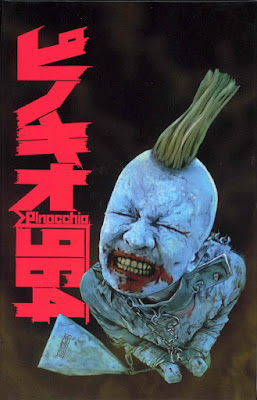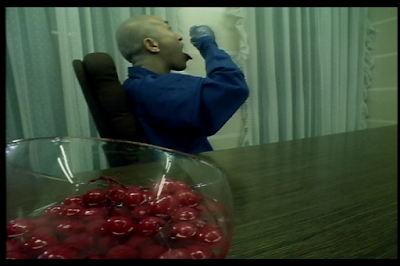 |
From http://www.strangevice.co.uk/img/products/
big/5212a1f7-a914-4606-b580-34fbcdbab37c.jpg |
Dir: Shozin Fukui
Screenplay: Shozin Fukui, Makoto
Hamaguchi and Naoshi Gôda
Cast: Haji Suzuki, Onn-chan, Kôji
Ôtsubo, Kyoko Hara, Rakumaro San'yûtei
97 mins
 Synopsis
Synopsis: A brain washed
"sex doll" (
Haji Suzuki) tattooed
with the code "964 Pinocchio" on his shoulder is tossed out into the
streets by his owners for being dysfunctional in his assigned purpose, left to
wander the urban environment as a disorientated baby-like figure with a tiny stub
of hair stood tall in his forehead and dressed in medical garb. By coincidence
he falls into the lap (literally) of a homeless woman Himiko (
Onn-chan) who takes him in. Dubbing him
Pinocchio from the branded tattoo, the two bond while she teaches him to talk
and looks after him. When he regains his awareness however a horrible
transformation occurs to both of them, he physically, Himiko losing her sanity,
and desiring then on to harm him, when she regains suppressed memories
connected to his past purpose. At the same time the secret company that
"made" Pinocchio, ran by an eccentric megalomaniac, is horrified to
learn their (illegal) sex slave is in the open free, sending lackeys out to
drag him back for reprogramming and to snuff anyone out who knows his existence.
Anarchy ensures.
The synopsis above is an attempt
to clear up the establishing plot to 964
Pinocchio. While in the same category of Japanese cyberpunk films like Shinya Tsukamoto's Tetsuo: The Iron Man (1989), there are differences as there are similarities,
fitting as Shozin Fukui worked on Tetsuo in the production crew. Like Tetsuo, it is a pulpy, transgressive
sci-fi story which has extensive use of abrasive editing and practical effects.
Tetsuo is in the same camp as 964 Pinocchio, with extra leanings into
old kaiju films and avant-garde gruel, but it proves to be an apt start to its
director Tsukamoto's career as, while
its more about the visceral nature of the content, it has hints of Tsukamoto's obsessions with human
emotions by way of extreme body changes. 964
Pinocchio is more about the upfront effect of the transgressive content on
its characters and is significantly more heightened in tone in comparison. It
is closer to Andrzej Zulawski's Possession (1981) in terms of a
spiritual sibling.
 |
From http://ilarge.lisimg.com/image/1081162/
968full-964-pinocchio-screenshot.jpg |
964 Pinocchio could come off as more cartoonish and weird, even
more a living manga than Tetsuo,
despite the strong connections Tsukamoto's
has to them, because of the passionate, hyperactive tone which you find in a
bit of manga (and anime). Very exaggerated performances, swear words in the
Japanese language track bleeped, (probably for effect), and violence that is abrupt
and visibly abrasive when it takes place. There's also a lot of running and
shouting. As with Tetsuo, the
environments used are far removed from those one would presume to be in a
cartoon, urban and industrial realism from a supermarket interior to wasteland.
The film adds to this verité with its rough aesthetic, shot in colour,
contradicting the content of the film and creating a greater intensity as a
result. Like Possession, there's a
tightrope walk between intensity and the silly that 964 Pinocchio takes a risk walking on. From the beginning you have
a level of absurdity that is clearly meant to be funny or at least silly,
starting with a villain who raves about his plans to control sex and eating
from a bowl of cherries he willingly lets his beautiful, bespectacled secretary
drool un-human amounts of water from her mouth into first. This with the moments of realism or brutality,
including an un-concluded subplot about a lackey wanting to adopt a child,
creates a stew of emotional states that whips you around in various directions
you don't find in many others films.
 |
| From http://www.eibonvale.co.uk/strangereviews/asia/pinocchio/cap070.jpg |
Pinocchio is depicted as a
literal child, wandering around in immense confusion muttering incoherently. A
prolonged scene at the supermarket, with a continuous moving camera, shows him
being dragged by his hand as he paws at food to eat indiscriminately with no
control like a young child. Shozin Fukui,
like in his short film Gerorisuto (1990),
takes advantage of shooting with real bystanders on location rather than
extras, the guerrilla style of capturing the scenes emphasising the chaos of
the narrative when the bystanders react and look on at what is taking place. The
most extreme of these moments, the bravado moment of the whole film, involves Haji Suzuki as Pinocchio when his
character is chained to a metal square pyramid* by his neck and
hands dragging the prop behind him as he runs through a large and crowded metropolitan
area, a sea of people splitting in half as he cuts through them for the scene.
 |
| From http://www.cyberpunkreview.com/images/964pinocchio06.jpg |
The performances are completely selfless from
the cast for their willingness to push themselves to extremes, more so the most
with Onn-chan as Himiko, who steals
the film with a level of insanity to the performance, after the character
starts off as a quiet, good natured person in the first act, that delivers a
level of elastic facial expressions and nakedness that very few actors would be
brave to act out on camera. Full of manic shapes and fits of deranged noises,
from skipping and weaving between pillars in an underground corridor to almost
changing her facial features into a different person's when she bugs out, it
does evoke the Possession
comparisons the most in lieu of Isabella
Adjani in Zulawski's film. The
infamous subway sequence from Possession
is evoked, as well as a key sequence from Gerorisuto**
being reinterpreted, when Himiko is involved with one of the longest
puking sequences I have seen in cinema which leads to the character rolling in
an amount, possibly done with rice, that is inhumanly impossible for any person
to project out from their body.
 |
| From http://www.cyberpunkreview.com/images/964pinocchio09.jpg |
Technical Details:
The skill in which the use of
tracking camera shots are used in the film stand out for the movie's
willingness, on a low budget, to push the level of kineticism possible despite
the production limitations. Inventive use of camera shots and framing, more so
in places than even the more famous Tetsuo:
The Iron Man, litter the movie and the moments of heavy editing do cause
the recommended effect of battering the viewer's senses in. The film is
intentionally subjective in what its plot is about - why the synopsis I've
written is as detailed as it is - and uses quick-frame editing techniques for
background content and memories characters rediscover to add to the confusion
they feel. Also adding to this these moments are either in monochrome or in
heavily saturated colour lighting.
The pulpy, transgressive content
will sate a cult movie fan as well. Knowing of old Japanese sci-fi films from
studios like Toho will actually make
the film, like Tetsuo, even more
entertaining in this area because the clear influence is there, from the
eccentric costume designs to plot devices like the gas gun the size of a
bazooka being giving to one character for clean-up of anyone who gets in the
way. Far from tacky it adds to the energy of the film when its content is as exaggerated.
 |
| From http://www.cyberpunkreview.com/images/964pinocchio14.jpg |
Abstract Spectrum: Psychotronic
Abstract Rating (High/Medium/Low/None): Medium
In terms of what the plot of 964 Pinocchio is actually about, I
personally prefer to see it as a moody genre piece than try to give it a
philosophical slant. For both this film and Rubber's Lover (1996) though, Fukui
does have a theme for them of catharsis through physical pain, and while it is the
later film took this idea to its fullest extent, it is visible here too but in
an embryo form. It is not hard to see the story of a sex doll developing his cognisance
through this concept. The ending, which involves a face being pulled off and a
ridiculous mushroom head that reminded me of the floating stone head from Zardoz (1974), not to mention a cameo
from the Eifel Tower, does show two characters after their traumatic
experiences becoming one entity and finding peace***. The coda, out
of context of the film's plot with the two main actors being filmed at a
concert, adds a sense of cathartic release linked to a snapshot of people
dancing to a noisy, electronically backed rock music in a dance club.
Rubber's Lover is a much more polished and consistently toned film,
which streamlines the eccentric humour in favour of more intensity and
dreamlike content. The black-and-white look instead of colour adds to its mood.
Said to be a prequel to 964 Pinocchio,
if there is a linking back-story between them it's that, after the disastrous
experiments in that film involving psychic power, it would be that someone
cleaned up the bloodbath that took place and, instead of trying to unlock ESP
abilities, found it better to lobotomise people and turn them into sex dolls to
sell to bisexual, tattooed women who want a third wheel to enjoy with her
diminutive girlfriend who dresses as a maid. Both films are in the high range
of "abstract" cult movies, Rubber's
Lover for its atmosphere, 964
Pinocchio for its energy and sentences like the former one I've just
written based on scenes as strange as they sound.
 |
| From http://www.cca.org/blog/images/p964/eating-cherries.png |
Personal
Opinion:
Finding Shozin Fukui's first two films, still sadly obscure in cult cinema
as a director, was a revelation. While it is difficult to pinpoint exact
reasons why this is very different from Tetsuo:
The Iron Man, the films are very different in mood and tone even though
they have clear similarities and connections. It does emphasis the richness of this
type of cinema when I've barely scrapped through the many Japanese cyberpunk films
that exist, and can still claim to have seen how the medium technically and
content can be pushed in innovative ways. Rubber's
Lover is my preferred of the two, Fukui's
career still productive in the 2000s but sadly not as large or accessible as Shinya Tsukamoto's, but 964 Pinocchio is no slouch in quality
either.
 |
From http://366weirdmovies.com/wp-content/uploads/
2010/07/964_pinocchio.jpg |
===========
* A literal square
pyramid made from metal found in a landfill. It makes no sense where it came
from, but considering the prelude of Himiko looking so happy in her derangement
running around a DIY store with a shopping trolley and a welder's helmet on, I
won't complain about the absurdity of the object's shape.
** Gerorisuto is a series of events
involving a young woman losing her sanity. Scenes in the short include a
prolonged moment of vomiting and an extended one on a crowded street at night
time when she interacts with (real) bystanders who step away when she grabs or
clings to them. I wouldn't be surprised if this short became a test run, even
if in hindsight, and was cannibalised for key moments in the director's debut
feature.
*** Strangely that
also evokes Neon Genesis Evangelion
(1995-1996), thus invoking the Third Impact and Synchronisation with Sean Connery in a nappy in one sentence.
Whether any other films I cover can top that juxtaposition is up in the air.








